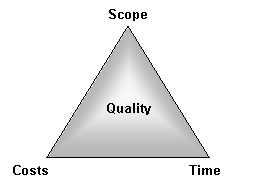Project Management
Project Management is the discipline of planning, organising, and managing resources to bring about the successful completion of specific project goals and objectives. It aims achieve all of the project objectives and work within the project constraints. In addition, it tries to optimize the allocation and integration of inputs necessary to meet project objectives. A project is a temporary, finite and defined set of activities to achieve specific objectives using resources. A project manager may not participate directly in the activities that produce the end result. However, a successful project manager must be able to envision the entire project from start to finish and have the ability to get the project to successful outcomes. His or her main responsibilities are to ensure smooth progress of the project, manage risks and maintain productive communication among various parties.
Project Constraints
Most projects need to be delivered under the constraints of time (time to complete), scope (deliverables and its quality) and costs (budget). These constraints are also known as the Project Management Triangle where any side of the triangle cannot be changed without having an impact on the others. For example, an increased scope typically means increased time and increased cost. A highly constrained project may suffer from quality issues.

A project is considered successful when the pre-defined objectives are delivered, on-time, on-specifications and on-budget.
- Time - To analyse the amount of time required to complete the project, one way is to estimate the time required to deliver the individual tasks within and roll up to a combined estimate. A technique to do that is by using the Work Breakdown Structure (WBS). The iindividual tasks are first identified and the effort required for each task can be estimated. The tasks are prioritised and inter-dependencies are worked out. All these information is documented in a project schedule to determine the overall time required for the project.
- Cost - The cost related to deliver a project includes labour, material, contingency, equipment, indirect costs, etc.
- Scope - The scope of the project defines the requirements of the end outcome. Components of the scope may include the start and end points of the target process, the range of product family under development, implementation of a certain technology or delivery of specific product features. The quality of the project could also be included in the scope of the project.
Project Stages
Any project will have roughly the same stages at a high level such as initiate, design, execute, monitor and control, close.
Initiate
The initiate stage determines the scope of the project and creates a plan to deliver the desired objectives under the time and cost constraints. It is important at this stage to make sure that the project is aligned to the needs of the stakeholders and the business. It requires the project manager to have a good understanding of the business environment and incorporate necessary controls into the project. The initiate stage is similar to the Define phase in the DMAIC methodology. The initiation stage should include a cohesive plan that encompasses:
- Customer / business needs analysis
- Overview of the current operations
- Cost and benefit analysis
- Team Composition
- Stakeholders analysis
- Communication Plan
- Project charter
Design
In the design stage, the current operations is thoroughly analysed to develop a design for the system. A prototype may be built or a pilot may be carried out to ensure that the system will meet the project objective. This stage is similar to the Measure and Analyse phases in the DMAIC methodology.
Execute
The execute stage consists of the activities to complete the project and accomplish the project objectives. It involves coordinating people and resources, as well as integrating and performing the activities of the project in accordance with the project management plan. This stage is similar to the Improve phase in the DMAIC methodology.
Monitor and Control
In this stage, the execution of the project is under careful observation so that potential problems can be identified early and corrective action can be taken in a timely manner. This stage is similar to the Control phase in the DMAIC methodology.
Close
The Close stage includes the acceptance of the project deliverables and documentation activities.